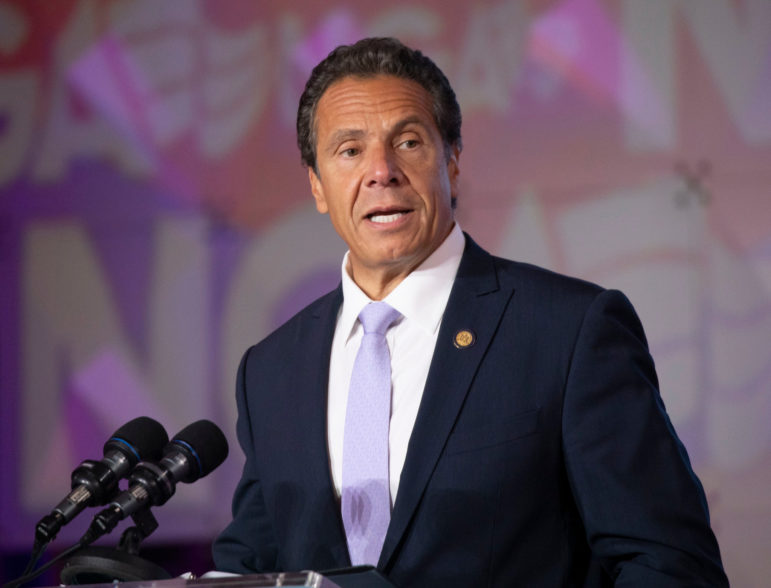
Office of the Governor
Governor Andrew Cuomo
Over the course of his four successful statewide races—from the 2006 campaign where he was elected attorney general through his three triumphant gubernatorial bids—Andrew Cuomo has received more than 920,000 votes on ballot lines other than the one belonging to his Democratic Party. That’s a small share of the 11 million votes the governor has received overall. But those third-party votes, or the possibility they might go to someone else, evidently have had real significance, for they are why Cuomo recorded an awkward video message to the Working Families Party in 2014, created his own party later that year, and now is trying to use the state’s campaign-finance reform process to stop future candidates from benefitting from the cross-party advantages he has enjoyed.
Fusion voting—the mechanism by which third parties cross-endorse major party candidates—has deep history in New York City and state. Republican Mayors LaGuardia, Lindsay and Giuliani all were elected with critical support from third parties. The American Labor Party helped then-Governor Franklin Roosevelt to become president and Herbert Lehman to become governor. More recently, it’s empowered the Working Families Party in its push for progressive policies (and the Conservative Party as it tugged the other way).
But fusion voting can present voters with an array of indistinct choices. What did it mean in 2014 that voters split votes for Cuomo across the Democratic, Working Families, Independent and Women’s Equality lines, or that supporters of his opponent, Rob Astorino, pulled the lever for Republican, Conservative or Stop Common Core? What was a Bill de Blasio-hating voter to do in 2017 when confronted with a “Dump the Mayor” candidate and a “Stop de Blasio” rival? And why should third parties that refuse to cross-endorse major-party candidates, like the Greens, have to share ballot space with parties that almost always echo major-party endorsements?

Ben Max
Stanley Fritz, seen in 2018
“Fusion voting should exist because if we want to have legitimate third parties that people can feel comfortable voting for and not playing the spoiler, then it gives us the option,” Stanley Fritz, the political director at Citizen Action NY, told WBAI’s Max & Murphy Show on Wednesday. Instead of taking a vote away from the less-offensive major-party choice and giving it to a third party that is unlikely to win, he argued, fusion voting allows a voter to send a signal. “Fusion voting gives a voter a chance to make two statements: one about the issues they care about and another about the candidate they want to move forward.”
“It gives people who identify as neither Democratic nor Republican a chance to participate,” Fritz added.
The current debate over fusion voting actually encompasses three separate questions. One is whether fusion voting is a good thing. A second is whether the state has the authority to tell political parties whom they can or cannot nominate. And the third is whether the process of designing a public-financing system for state campaigns—a process already muddied when elected leaders passed the buck from designing the system to a bespoke commission—is really the place to tinker with the mechanics of party preference.
“Let’s not forget that this is supposed to be a conversation about campaign finance reforms and we can’t even have a serious conversation about what a six-to-one match should look like in New York state because the governor slipped this into the atmosphere and distracted all of us,” Fritz said. (The six-to-one match refers to the likely ratio of public funds to qualifying private campaign contributions under the coming state system.)
Under the law empowering the campaign-finance commission, it must present a plan for the new public-financing system (including any steps to change fusion voting) by December 1, and that proposal becomes state law—unless lawmakers move within three weeks to reject the whole package. Asked if CitizenAction would recommend rejection if an otherwise excellent campaign-finance proposal includes a prohibition on fusion voting, Fritz said he cannot speak for the organization. But personally?
“I wouldn’t want that deal,” he said. “Fusion voting and a six-to-one match is what you need in order for working people and people of color and women to run for office and have a viable shot.”
(Reporting by Xavier Means.)
Hear our conversation with Fritz below, or listen to Wednesday’s full episode, which includes a chat with the Manhattan Institute’s Nicole Gelinas about the new MTA capital plan:







